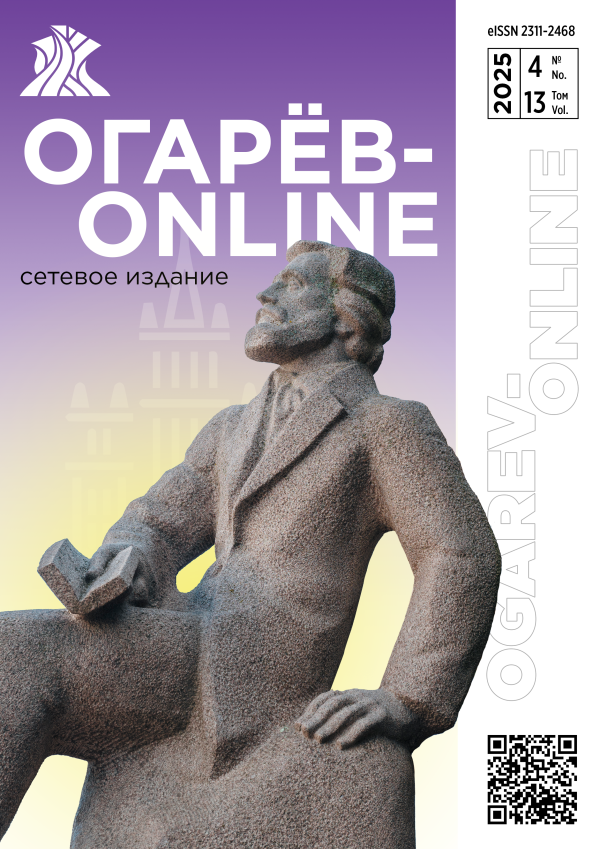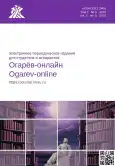Vol 7, No 5 (2019)
- Year: 2019
- Published: 05.05.2019
- Articles: 10
- URL: https://ogarev-online.ru/2311-2468/issue/view/18225
Full Issue




The effect of baked clay additives on the strength of cement stone
Abstract
The article studies the effects of preparation technological parameters and a mineral additive based on baked clay on the strength of cement composites. The authors show a way of improving the physical and mechanical properties of the composites by optimizing the mode of clay burning and the content of the developed additive.


Overview of advanced design solutions for vacuum heat-insulation panels to use in building and construction industry
Abstract
The article provides an overview of available design solutions for vacuum heat-insulation. The options for combining a vacuum heat-insulation panel with a variety of cladding and structural materials are studied. The options for attaching the panel layers between themselves and the panel as a whole to the supporting structures of the building are studied. The advantages and disadvantages of the use of powder insulation in comparison with traditionally used heat-insulation materials are considered.


Comparative analysis of AutoCAD and ArchiCAD functions: a case study of conceptual model of office building
Abstract
This article provides a comparative analysis of the ways of realization of the conceptual model of an office building in the framework of the new approach to designing – building information modeling. It is shown that each of the computer-aided design systems considered has its specificity, its advantages in certain areas and activities, and their functional characteristics allow to solve various types of tasks with varying degrees of effectiveness. As examples the works of Master’s students in AutoCAD and ArchiCAD are presented.


Strengthening of building structures by impregnation
Abstract
Strengthening of building structures by impregnation of the composite material with sodium salts is considered. The graphs showing dependences of the degree and size of the filler on the strength of cement stone are given. Different methods of impregnation of filled cement composites were compared. The analysis of the polarization curves of reinforcing steel in the filtrate obtained after holding the cement stone in an aqueous solution of sodium fluoride is provided.




Analysis of the influence of microcalcite on the efficiency of joint work of filled polymer coatings with concrete bases
Abstract
The paper presents the study results of the joint work of microcalcite-filled polymer coatings with concrete bases. The analysis of change of bending strength and maximum deflection of concrete samples with the filled polymer coating based on epoxy resins depending on the degree of filling and the fractional composition of microtremor was carried out with the use of contour lines and three-component diagrams of Rozebom-Gibbs. The study revealed the compositions of polymer coatings that provide the greatest increase in strength characteristics even when using high-filled mixtures with a minimum consumption of the binder.


Atemarskiy diatomite as raw material to obtain microsilica
Abstract
The analysis of diatomite rocks of the Atemar Deposit of the Republic of Mordovia is carried out. The procedure of analysis of silicate rock, used for obtaining microsilica from natural diatomite, is described. A comparative analysis of the synthesized microsilica and the standard white soot powder is presented. A thermo-grav analysis of the synthesized microsilica obtained from Atemarskiy diatomite is carried out. The parameters of the thermal conductivity of the obtained microsilica are provided.


Climatic resistance of epoxy polymers with improved UV resistance
Abstract
The possibility of increasing the climatic resistance of epoxy polymers through the use of a hardener with high resistance to the action of UV radiation, as one of the main environmental factors, has been analyzed. The differences in the sorption and elastic-strength characteristics of samples of epoxy polymers based on hardeners Etal-45M and Etal-2MK, exposed on the test benches of the Ecological and Meteorological Laboratory of Ogarev Mordovia State University for 12 months, established. The possibility of using hardener Etal-2MK to obtain epoxy polymers with high stability properties under environmental conditions has been shown.
















